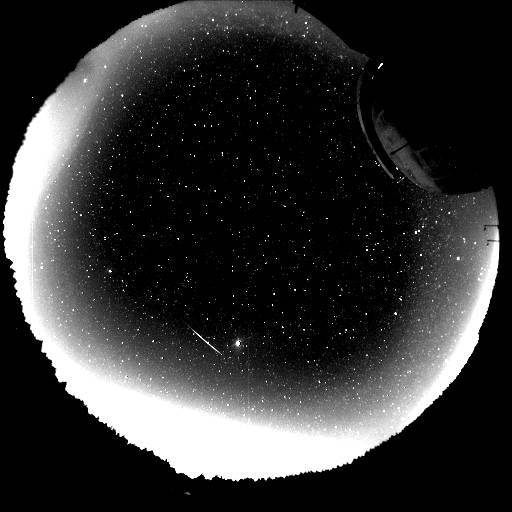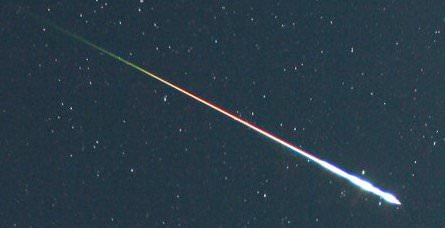Talk about a light show! A massive bolide was captured on video during a middle-of-the-night rock concert in Argentina on April 21, 2013. The band, Los Tekis performed at an outdoor concert venue and in perfect timing, right after the band concluded a song, the person who shot the video panned out so that the sky was visible — just as the bolide lit up the sky.
Continue reading “Bright Meteor Rocks Argentina Rock Concert”
This Weekend’s Lyrid Meteor Shower: How to See It
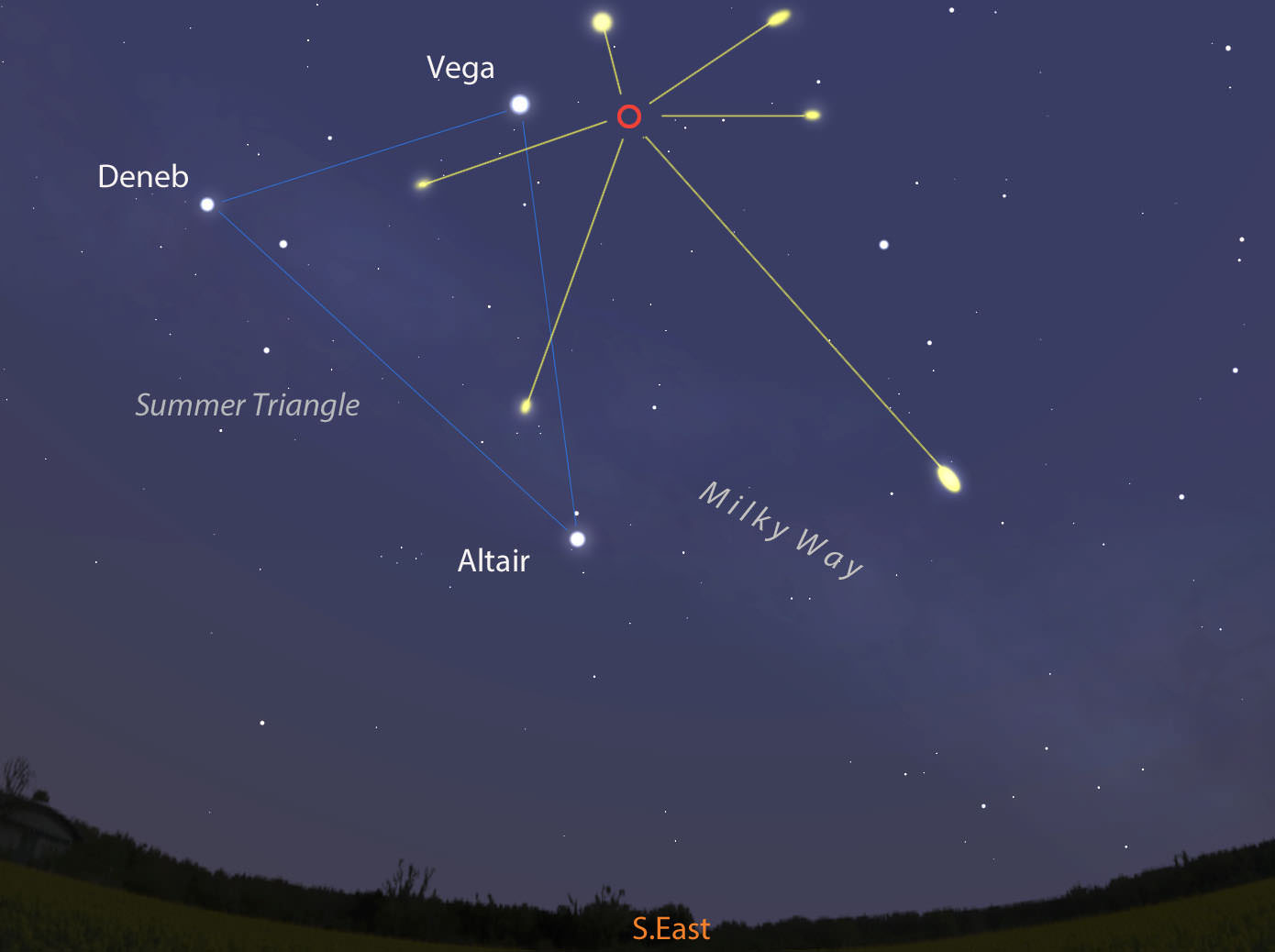
Feeling a little meteor-starved lately? Me too. It’s been a meteor shower desert since the Quadrantids of early January. That’s about to change. This weekend brings the celestial version of April showers with the annual appearance of the Lyrids.
The Lyrids ding the bell at maximum strength this weekend April 21-22 (Sunday night-Monday morning in the Americas) hurtling meteors at the modest rate of 10-20 per hour from a point in the sky not far from bright Vega in the constellation Lyra. While some showers spread their meteor crumbs over several days, the Lyrids’ peak activity lasts less than a day. The western hemisphere – particularly the western half of North America – is favored this year.
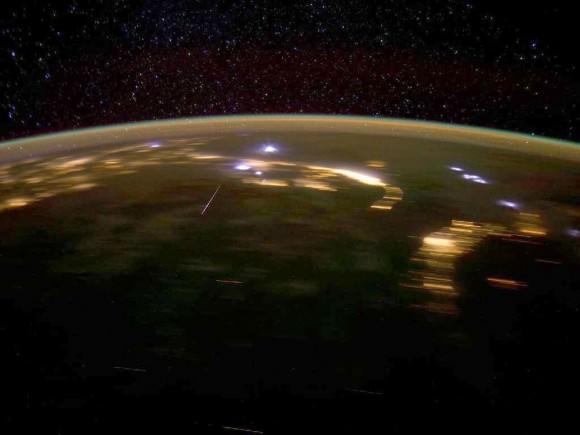
There will be a small price to pay for the show. The Lyrid radiant, the point in the sky from which the showers members radiate, rises in the east rather late – around 10:30 p.m. local time. Then there’s the bright gibbous moon, which has a habit of drowning out fainter stars and meteors alike. That makes the best time for viewing the shower after moonset or around 4 a.m. Monday morning. Since dawn begins about 5, you’ll have one good hour. That’s plenty of time to snag at least a few flaming motes of Comet Thatcher.
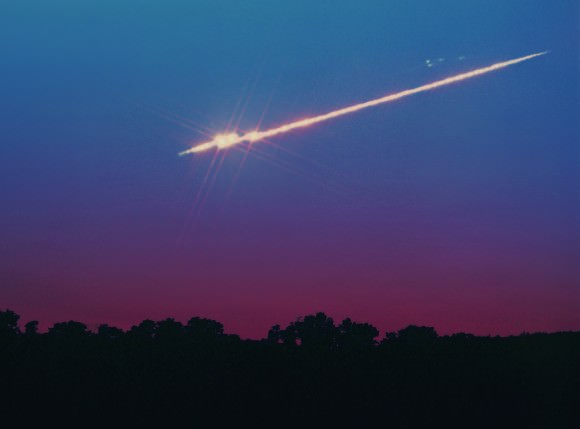
Like most meteor showers, the Lyrids have a parent and single parents are the rule. For the Lyrids, it’s Comet Thatcher, discovered on April 5, 1861, a week before the start of the Civil War, by amateur astronomer A.E. Thatcher observing from New York City. Later it was found to be linked to the Lyrid meteor shower.
Each year in late April, Earth passes through centuries of dust shed by the comet’s tail. When bits of Thatcher flotsam strike the air some 60-70 miles high, they burn up in flashes of meteoric light. Comet tears.
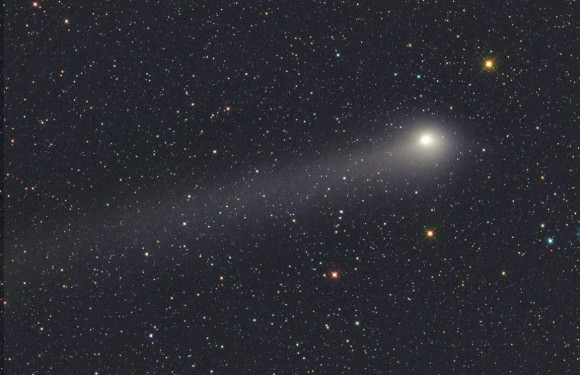
All meteors are worthy of keeping an eye on, but bear in mind that the Lyrids are no Perseids, the famed summertime shower offering up to 60 meteors per hour under dark skies. But what they lack in numbers, they make up in reliability and surprise.
Records indicate that people have been watching the Lyrids for at least 2,600 years, the longest of any shower. Our oldest descriptions come from the Chinese who penned that “stars fell like rain” on March 16, 687 BC. Apparently the shower was more active in the past and has since evolved into a minor display. But there have been occasional surprises, and that’s what keeps the Lyrids interesting.
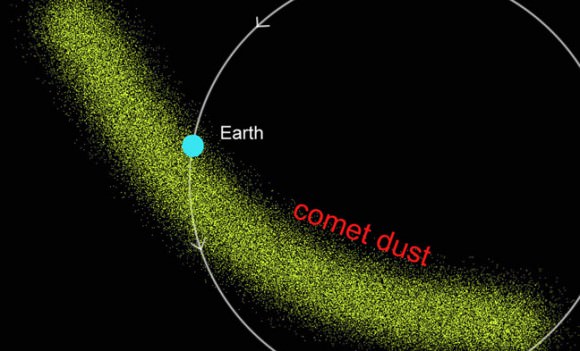
On April 20, 1803 a fire bell roused Richmond, Virginia residents from their beds to witness a similar rain of stars when up to 700 meteors per hour were seen. Other Lyrid outbursts occurred in 1922 (100 per hour), 1945 (100/hr), 1982 (90/hour). Last year’s peak hit 37 per hour from a dark sky site. Now and then, Earth encounters a thicker band of comet debris left behind by Comet Thatcher, suddenly increasing the meteor count by many times and just as suddenly dropping back to the usual 10-20 per hour.
So here’s the bottom line. Don’t expect a big blast, but do avail yourself of the leisurely pleasure of meteor watching and the possibility of seeing pieces of a comet that rounds the sun only every 415 years. Find a spot where artificial lights is at a minimum, dress warmly and head out around 3:30 a.m. Monday. Set up a comfortable lawn chair and have tea or coffee and a blanket at the ready. You’ll do well to face south or east. Now recline back to allow a fulsome view of the sky above and wait for a few well-deserved ooohs and aaahs.
Russian Fireball Inspires Journey into the World of Meteorites
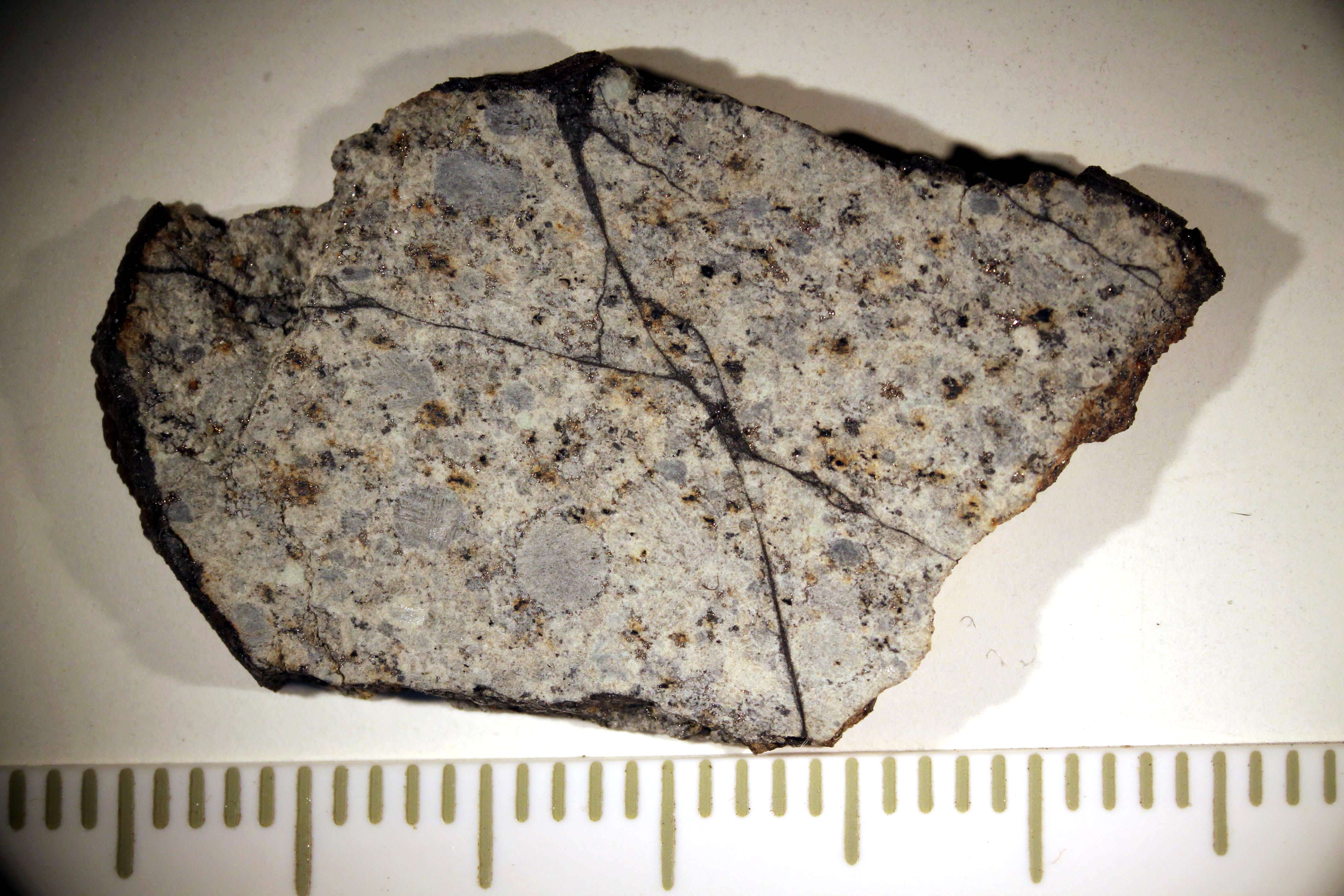
A little more than week ago a 7,000 ton, 50-foot (15-meter) wide meteoroid made an unexpected visit over Russia to become the biggest space rock to enter the atmosphere since the Tunguska impact in 1908. While scientists still debate whether it was asteroid or comet that sent a tree-flattening shockwave over the Tunguska River valley, we know exactly what fell last Friday.
Now is a fitting time to get more familiar with these extraterrestrial rocks that drop from out of nowhere.
The Russian meteoroid – the name given an asteroid fragment before it enters the atmosphere – became a brilliant meteor during its passage through the air. If a cosmic rock is big enough to withstand the searing heat and pressure of entry, fragments survive and fall to the ground as meteorites. Most of the meteors or “shooting stars” we see on a clear night are bits of rock the size of apple seeds. When they strike the upper atmosphere at tens of thousands of miles an hour, they vaporize in a flash of light. Case closed. But the one that boomed over the city of Chelyabinsk was big enough to to survive its last trip around the Sun and sprinkle the ground with meteorites.
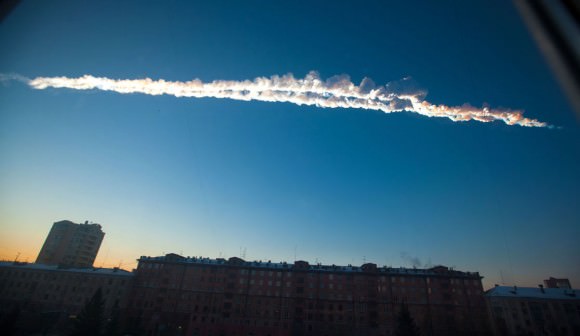
Ah, but the Russian fireball didn’t get off the hook that easy. The overwhelming air pressure at those speeds combined with re-entry temperatures around 3,000 degrees F (1,650 C) shattered the original space rock into many pieces. You can see the dual trails created by two of the larger hunks in the photo above.
Scientists at Urals Federal University in Yekaterinburg examined 53 small meteorite fragments deposited around a hole in ice-covered Chebarkul Lake 48 miles (77 km) west of Chelyabinsk the following day. Chemical analysis revealed the stones contained 10% iron-nickel metal along with other minerals commonly found in stony meteorites. Since then, hundreds of fragments have been dug out of the snow by people in surrounding villages. As specimens continue to be recovered and analyzed, here’s an overview — and a look at what we know — of these space rocks that pay us a visit from time to time.

How many times has a meteor taken your breath away? A brilliant fireball streaking across the night sky ranks among the most memorable astronomical sights most of us will ever see. Like objects in your side view mirror, meteors appear closer than they really are. And it’s all the more true when they’re exceptionally bright. Studies show however that meteors burn up at least 50 miles (80 km) overhead. If big enough to remain intact and land on the ground, the fragments go completely dark 5-12 miles (8-19 km) high during the “dark flight” phase. A meteor passing overhead would be at the minimum distance of about 50 miles (80 km) from the observer.
Since most sightings are well off toward one direction or another, you have to add your horizontal distance to the meteor’s height to get a true distance. While some meteors are bright enough to trick us into thinking they landed just over the next hill, nearly all are many miles away. Even the Russian meteor, which put on a grand show and blasted the city of Chelyabinsk with a powerful shock wave, dropped fragments dozens of miles to the west. We lack the context to appreciate meteor distances, perhaps unconsciously comparing what we see to an aerial fireworks display.
Very cute Youtube video of Sasha Zarezina, 8, who lives in a small Siberian village, as she hunts for meteorite fragments in the snow after Friday’s meteor over Russia. Credit: Ben Solomon/New York Times
An estimated 1,000 tons (907 metric tons) to more than 10,000 tons (9,070 MT) of material from outer space lands on Earth every day delivered free of charge from the main Asteroid Belt. Crack-ups between asteroids in the distant past are nudged by Jupiter into orbits that cross that of Earth’s. Most of the stuff rains down as micrometeoroids, bits of grit so small they’re barely touched by heating as they gently waft their way to the ground. Many larger pieces – genuine meteorites – make it to Earth but are missed by human eyes because they fall in remote mountains, deserts and oceans. Since over 70% of Earth’s surface’s is water, think of all the space rocks that must sink out of sight forever.
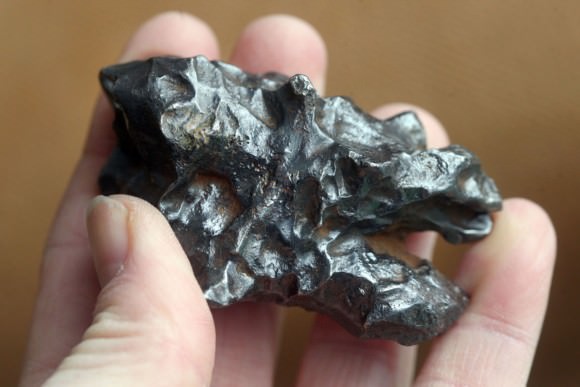
About 6-8 times a year however, a meteorite-producing fireball streaks over a populated area of the world. Using eyewitness reports of time, direction of travel along with more modern tools like video surveillance cameras and Doppler weather radar, which can ping the tracks of falling meteorites, scientists and meteorite hunters have a great many clues on where to look for space rocks.
Since most meteorites break into pieces in mid-air, the fragments are dispersed over the ground in a large oval called the strewnfield. The little pieces fall first and land at the near end of the oval; the bigger chunks travel farthest and fall at the opposite end.
When a new potential meteorite falls, scientists are eager to get a hold of pieces as soon as possible. Back in the lab, they measure short-lived elements called radionuclides created when high-energy cosmic rays in space alter elements in the rock. Once the rock lands on Earth, creation of these altered elements stops. The proportions of radionuclides tell us how long the rock traveled through space after it was ejected by impact from its mother asteroid. If a meteorite could write a journal, this would be it.
Other tests that examine the decay of radioactive elements like uranium into lead tells us the age of the meteorite. Most are 4.57 billion years old. Hold a meteorite and you’ll be whisked back to a time before the planets even existed. Imagine no Earth, no Jupiter.
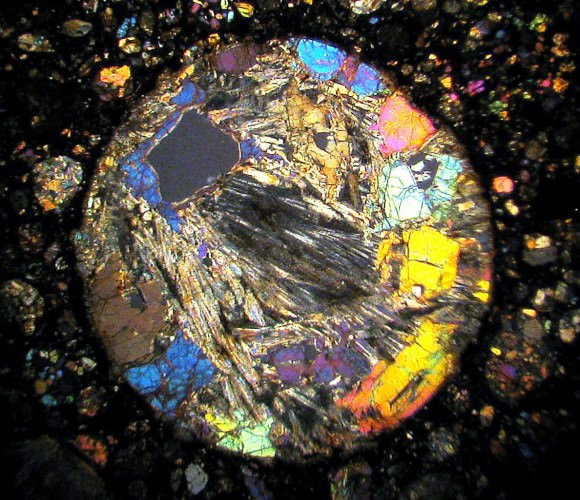
Many meteorites are jam-packed with tiny rocky spheres called chondrules. While their origin is still a topic of debate, chondrules (KON-drools) likely formed when blots of dust in the solar nebula were flash-heated by the young sun or perhaps by powerful bolts of static electricity. Sudden heating melted the motes into chondrules which quickly solidified. Later, chondrules agglomerated into larger bodies that ultimately grew into planets through mutual gravitational attraction. You can always count on gravity to get the job done. Oh, just so you know, meteorites are no more radioactive than many common Earth rocks. Both contain trace amounts of radioactive elements at trifling levels.
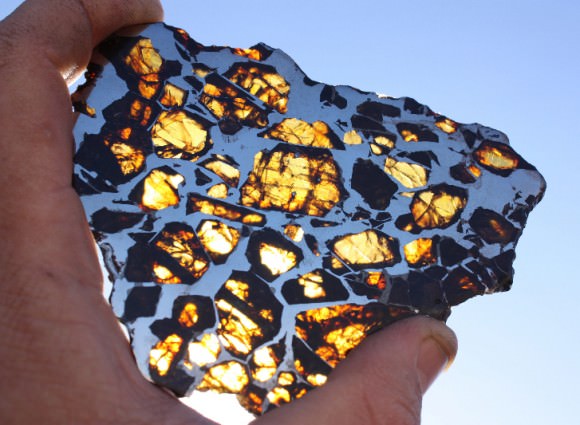
Meteorites fall into three broad categories – irons (mostly metallic iron with smaller amounts of nickel), stones (composed of rocky silicates like olivine, pyroxene and plagioclase and iron-nickel metal in form of tiny flakes) and stony-irons (a mix of iron-nickel metal and silicates). The stony-irons are broadly subdivided into mesosiderites, chunky mixes of metal and rock, and pallasites.
Pallasites are the beauty queens of the meteorite world. They contain a mix of pure olivine crystals, better known as the semi-precious gemstone peridot, in a matrix of iron-nickel metal. Sliced and polished to a gleaming finish, a pallasite wouldn’t look out of place dangling from the neck of an Oscar winner. About 95% of all found or seen-to-fall meteorites are the stony variety, 4.4% are irons and 1% stony-irons.
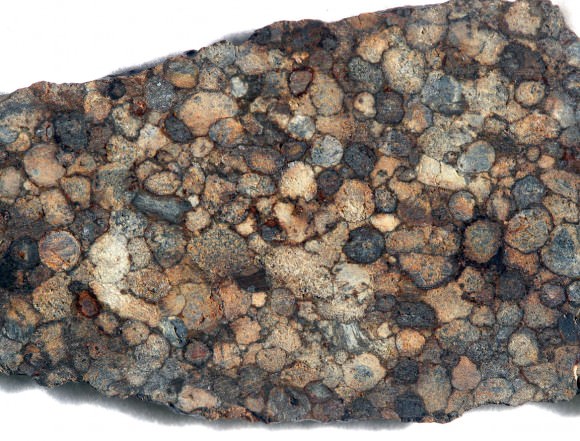
Earth’s atmosphere is no friend to space rocks. Collecting them early prevents damage by the two things most responsible for keeping us alive: water and oxygen. Unless a meteorite lands in a dry desert environment like the Sahara or the “cold desert” of Antarctica, most are easy prey to the elements. I’ve seen meteorites collected and sliced open within a week after a fall that already show brown stains from rusting nickel-iron. Antarctica is off-limits to all but professional scientists, but thanks to amateur collectors’ efforts in the Sahara Desert, Oman and other regions, thousands of meteorites including some of the rarest types, have come to light in recent years.

Hunters share their finds with museums, universities and through outreach efforts in the schools. A portion of the material is sold to other collectors to finance future expeditions, pay for plane tickets and sit down to a good meal after the hunt. Finding a meteorite of your own is hard but rewarding work. If you’d like to have a go at it, here’s a basic checklist of qualities that separate space rocks from Earth rocks:
* Attracts a magnet. Most meteorites – even stony ones – contain iron.
* Most are covered with a matt-black, slightly bumpy fusion crust that colors dark brown with age. Look for hints of rounded chondrules or tiny bits of metal sticking up through the crust.
* Aerodynamic shape from its flight through the atmosphere, but be wary of stream-eroded rocks which appear superficially similar
* Some are dimpled with small thumbprint-like depressions called regmaglypts. These form when softer materials melt and stream away during atmospheric entry. Some meteorites also display hairline-thin, melted-rock flow lines rippling across their exteriors.
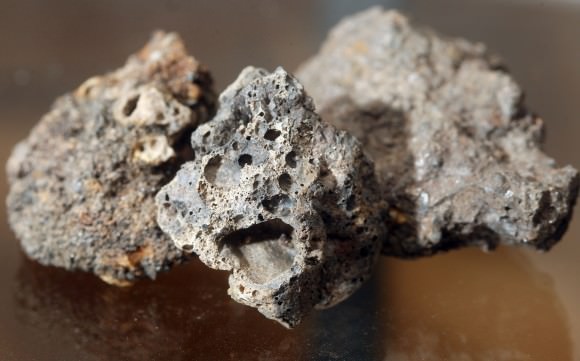
Should your rock passes the above tests, file off an edge and look inside. If the interior is pale with shining flecks of pure metal (not mineral crystals), your chances are looking better. But the only way to be certain of your find is to send off a piece to a meteorite expert or lab that does meteorite analysis. Industrial slag with its bubbly crust and dark, smooth volcanic rocks called basalts are the most commonly found meteor-wrongs. We imagine that meteorites must have bubbly crust like a cheese pizza; after all, they’ve been oven-baked by the atmosphere, right? Nope. Heating only happens in the outer millimeter or two and crusts are generally quite smooth.
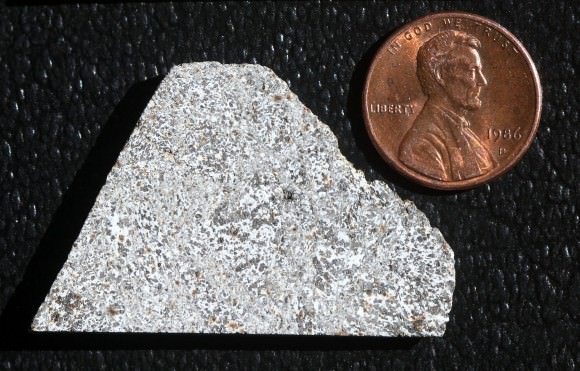
Stony meteorites are further subdivided into two broad types – chondrites, like the Russian fall, and achondrites, so-called because they lack chondrules. Achondrites are igneous rocks formed from magma deep within an asteroid’s crust and lava flows on the surface. Some eucrites (YOU-crites), the most common type of achondrite, likely originated as fragments shot into space from impacts on Vesta. Measurements by NASA’s Dawn space mission, which orbited the asteroid from July 2011 to September 2012, have found great similarities between parts of Vesta’s crust and eucrites found on Earth.
We also have meteorites from Mars and the Moon. They got here the same way the rest of them did; long-ago impacts excavated crustal rocks and sent them flying into space. Since we’ve studied moon rocks brought back by the Apollo missions and sampled Mars atmosphere with a variety of landers, we can compare minerals and gases found inside potential moon and Mars meteorites to confirm their identity.
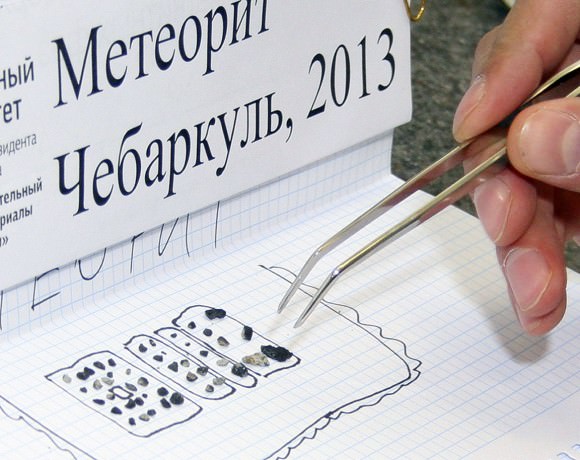
Scientists study space rocks for clues of the Solar System’s origin and evolution. For the many of us, they provide a refreshing “big picture” perspective on our place in the Universe. I love to watch eyes light up with I pass around meteorites in my community education astronomy classes. Meteorites are one of the few ways students can “touch” outer space and feel the awesome span of time that separates the origin of the Solar System and present day life.
Infographic: What’s the Difference Between a Comet, Asteroid and Meteor?
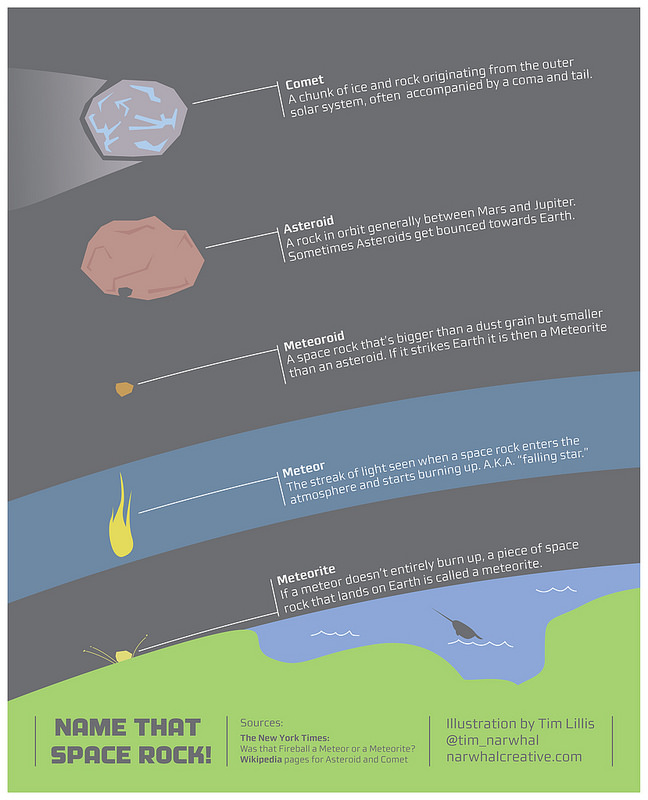
With all the various space rocks flying by and into Earth last Friday, perhaps you’ve been wondering about the correct terminology, since a rock from space has different names depending on what it is made of and where it is.
Infographics artist Tim Lillis has put together a primer of sorts, in the form of an infographic, describing the different between a comet, asteroid, meteoroid, meteor and meteorite.
Asteroids are generally larger chunks of rock that come from the asteroid belt located between the orbits of Mars and Jupiter. Sometimes their orbits get perturbed or altered and some asteroids end up coming closer to the Sun, and therefore closer to Earth.
Comets are much like asteroids, but might have a more ice, methane, ammonia, and other compounds that develop a fuzzy, cloud-like shell called a coma – as well as a tail — when it gets closer to the Sun. Comets are thought to originate from two different sources: Long-period comets (those which take more than 200 years to complete an orbit around the Sun) originate from the Oort Cloud. Short-period comets (those which take less than 200 years to complete an orbit around the Sun) originate from the Kuiper Belt.
Space debris smaller than an asteroid are called meteoroids. A meteoroid is a piece of interplanetary matter that is smaller than a kilometer and frequently only millimeters in size. Most meteoroids that enter the Earth’s atmosphere are so small that they vaporize completely and never reach the planet’s surface. And when they do enter Earth’s atmosphere, they gain a different name:
Meteors. Another name commonly used for a meteor is a shooting star. A meteor is the flash of light that we see in the night sky when a small chunk of interplanetary debris burns up as it passes through our atmosphere. “Meteor” refers to the flash of light caused by the debris, not the debris itself.
If any part of a meteoroid survives the fall through the atmosphere and lands on Earth, it is called a meteorite. Although the vast majority of meteorites are very small, their size can range from about a fraction of a gram (the size of a pebble) to 100 kilograms (220 lbs) or more (the size of a huge, life-destroying boulder).
Thanks again to Tim Lillis for sharing his infographic with Universe Today. For more info about Tim’s work, see his Behance page, Flickr site, Twitter, or his website.
Airburst Explained: NASA Addresses the Russian Meteor Explosion
A small asteroid entered Earth’s atmosphere early Friday, February 15, 2013 over Chelyabinsk, Russia at about 9:20 am local Russian time. Initial estimates, according to Bill Cooke, lead for the Meteoroid Environments Office at NASA’s Marshall Space Flight Center, is that the asteroid was about 15 meters (50 feet) in diameter, with a weight of 7,000 metric tons. It hit the atmosphere at a shallow angle of about 20 degrees, at a speed of about 65,000 km/h (40,000 mph).
It traveled through the atmosphere for about 30 seconds before breaking apart and producing violent airburst ‘explosion’ about 20-25 km (12-15 miles) above Earth’s surface, producing an energy shockwave equivalent to a 300 kilotons explosion. That energy propagated down through the atmosphere, stuck the city below – the Chelyabinsk region has a population of about 1 million — and windows were broken, walls collapsed and there were other reports of minor damage throughout the city.
The official impact time was 7:20:26 p.m. PST, or 10:20:26 p.m. EST on Feb. 14 (3:20:26 UTC on Feb. 15).
Cooke said that at this time, the known damage is not due to fragments of the bolide striking the ground but only from the airburst. “There are undoubtedly fragments on the ground, but at the current time no pieces have been recovered that we can verify with any certainty,” Cooke said during a media teleconference today.
He added that the space rock appears to be “an asteroid in nature,” – likely a rocky asteroid since it broke apart in the atmosphere. It wasn’t detected by telescopes searching for asteroids because of its small size, but also because “it came out of the daylight side of our planet – was in the daylight sky and as a result was not detected by any earth based telescopes. #RussianMeteor was not detected from Earth because it came from the daylight side (i.e the Sun-facing side of Earth).
The meteor left a trail in the sky about 480 km (300 miles) long.
Cooke, along with Paul Chodas, a research scientist in the Near Earth Object Program Office at NASA’s Jet Propulsion Laboratory said that asteroids this size hit the Earth on average about once every 100 years. “These are rare events, and it was an incredible coincidence that it happened on the same day as the close flyby of Asteroid 2012 DA14,” Chodas said. “The two are not related in any way.”
The Russian meteor is the largest reported since 1908, when a meteor hit Tunguska, Siberia. Oddly enough, the Tunguska event was caused by an object about the size of 2012 DA14, the asteroid that flew by Earth today harmlessly. The meteor, which was about one-third the diameter of asteroid 2012 DA14, became brighter than the Sun, as seen in some of the videos here. Its trail was visible for about 30 seconds, so it was a grazing impact through the atmosphere.
There were certainly pieces that hit the ground, according to Jon M. Friedrich from Fordham University. “For something that created a bolide and sonic detonation of the size seen in Russia, it seems likely that fragments reached the earth,”Friedrich said in an email to Universe Today. “In fact, there are reports of a crater in a frozen lake and other locations that were in the path of the meteor. The resulting fragments are not likely large – I’d expect some of the absolute largest to be football to basketball sized, with many fragments being smaller, like marbles.”
Chodas said that defending the Earth against tiny asteroids like this is challenging issue, “something that is not currently our goal,” he said. “NASA’s goal it to find the larger asteroids. Even 2012 DA14 is on the smaller size. The tiny asteroid that hit over Russia is very difficult to detect, an in order to defend the Earth, the problem and issue there is to find these things early enough to do something about it if we wanted to divert it. While smaller asteroids are easier to divert, they are much more difficult to detect.”
“What an amazing day for near Earth objects,” Chodas said, “with two events happening on the same day.”
The lead animation courtesy of Analytical Graphics, Inc.
Latest Video of Asteroid 2012 DA14 Steaking Towards Close Shave with Earth – as Meteor explodes over Russia
Here’s the latest video of the fast approaching asteroid named 2012 DA14 that’s screeching towards our planet and set to give us all a very close shave this afternoon, shortly after 2 PM EST. NASA TV will provide Live coverage starting at 2 PM EST. Continue reading “Latest Video of Asteroid 2012 DA14 Steaking Towards Close Shave with Earth – as Meteor explodes over Russia”
Russian Meteor Not Related to Asteroid Flyby, NASA Confirms
The meteor that streaked over the skies of Russia — creating a shockwave that shattered windows, injuring upwards of 1,000 people — is not related to the asteroid that will whiz past Earth later today, (Feb.15), NASA has confirmed.
As many of our readers have noted in comments on our previous story on the Russian meteor, the trajectory of the Russian meteorite was significantly different than the trajectory of the asteroid 2012 DA14, making it a completely unrelated object.
“Information is still being collected about the Russian meteorite and analysis is preliminary at this point,” NASA said in a statement. “In videos of the meteor, it is seen to pass from left to right in front of the rising sun, which means it was traveling from north to south. Asteroid DA14’s trajectory is in the opposite direction, from south to north.”
Images and video of the Russian bolide taken from satellites in Earth orbit confirm the trajectory:
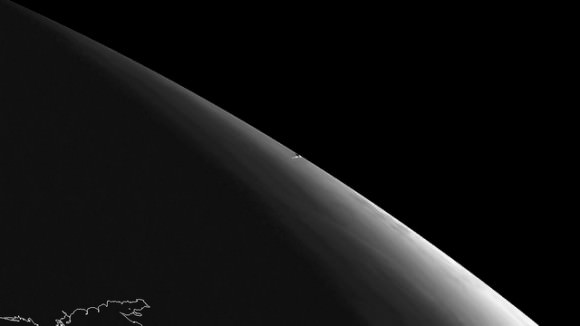
Reports are still coming in, but perhaps more than 1,000 people were injured, according to a statement from the Russian Emergency Ministry, primarily by glass cuts when windows were shattered from the shockwave blast. The vapor trail of the meteor was visible before the blast, so many people were standing in front of windows, looking at the trail visible across the sky.
The meteor appeared in the skies at around 09:25 a.m. local time in the Chelyabinsk region, near the southern Ural Mountains. It disintegrated and ‘exploded’ about 30-50 kilometers above Earth’s surface. The fireball blinded drivers and a subsequent explosion blew out windows. Reports of damaged buildings are being checked.
Initial estimates for the Russian Meteor are that it was a 1.5 meter-wide object weighing about 10 tons, traveling at 15 km/s.
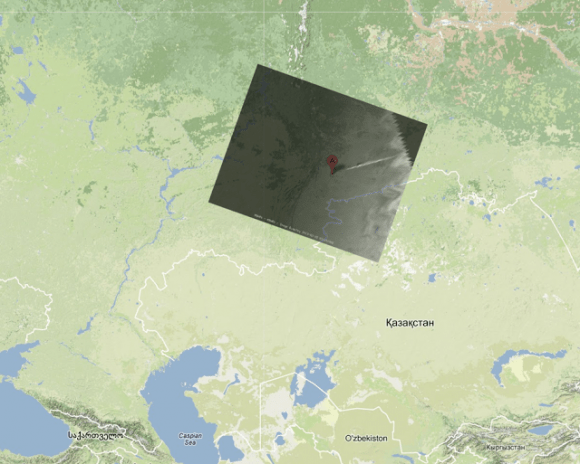
Nature News is reporting that this morning was the largest recorded object to strike the Earth in more than a century. “Infrasound data collected by a network designed to watch for nuclear weapons testing suggests that today’s blast released hundreds of kilotonnes of energy. That would make it far more powerful than the nuclear weapon tested by North Korea just days ago and the largest rock crashing on the planet since a meteor broke up over Siberia’s Tunguska river in 1908<" Nature News said.
[caption id="attachment_100015" align="aligncenter" width="580"]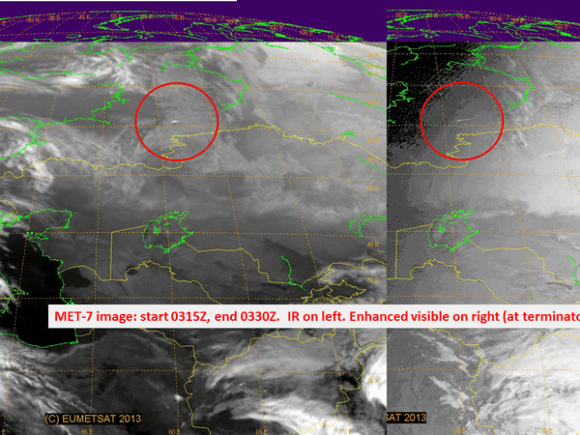 Satellite images from the European MET-7 weather satellite. Credit: EUMETSAT. [/caption]
Satellite images from the European MET-7 weather satellite. Credit: EUMETSAT. [/caption]
We’ll continue to provide updates on this story as they become available.
Geminid Meteor Shower and Meteorwatch
The Geminid Meteor Shower is the grand finale of astronomical events in 2012 and is usually the most reliable and prolific of the annual meteor showers.
This year we are in for a special treat as the Moon will be absent when the Geminids are at their peak on the evening of the 12th/ 13th of December. This means that the sky should be at its darkest when the shower is expected, and many more of the fainter meteors may be seen.
The Geminid meteor shower is expected to yield in excess of 50 meteors (shooting stars) per hour at peak for those with clear skies, the meteors it produces are usually bright with long persistent trains. If observing opportunities aren’t favorable or possible on the 12th/ 13th, meteor watchers can usually see high meteor activity a day or so either side of the peak.
As well as being the grand finale of 2012, the Geminids are special in another way. Unlike the majority of all the other annual meteor showers the Geminids are thought to be from an object known as 3200 Phaethon – an asteroid not a comet.
To celebrate this long anticipated event, there will be the Geminid Meteorwatch and anyone with an interest in the night sky can join in on Twitter, Facebook and Google+. The event will be an excellent opportunity to learn, share information, experiences, images and more. Whatever your level of interest, wherever you are on the planet Meteorwatch will run for approximately four days. All you need to do is follow along using the #meteorwatch hashtag.
As well as the wealth of information exchanged and shared on Twitter and the other social media outlets, there are helpful guides and information available on Meteorwatch.org so you can get the most out of your #meteorwatch.
To get the ball rolling there is a Hollywood style trailer for the event, purely as a bit of fun and for people of all walks of life to feel inspired and to go outside and look up. You don’t need a telescope or anything, just your eyes and a little bit of patience to see a Geminid meteor.
Good luck
Recent UK Fireball Could Not Have “Skipped” Around the World, New Analysis Says
The meteoroid seen over the UK on September 21, 2012 has created quite a sensation – make that a several sensations. First, the bright object(s) in the night sky were seen across a wide area by many people, and the brightness and duration – 40 to 60 seconds reported and videoed by some observers – had some experts wondering if the slow moving light-show might have been caused by space junk. But analysis by satellite tracker Marco Langbroek revealed this was likely an Aten asteroid, asteroid which have orbits that often cross the Earth’s orbit, but their average distance from the Sun is less than 1 AU, the distance from the Earth to the Sun.
Atens are fairly unusual, making this a rather unique event. But then came another analysis that seemed to be so crazy, it might have been true: this meteoroid may have skipped like a stone in and out of Earth’s atmosphere, where it slowed enough to orbit the Earth until appearing as another meteor over Canada, just a few hours after it was seen over the UK and northern Europe.
How amazing that would have been! And there was much speculation about this possibility. But, it turns out, after more details emerged and further investigation ensued, it is not possible that the space rock could have boomeranged around the world and been seen in again 2½ hours later over Canada. However, the current thinking is that at least one or two of the largest pieces retained enough velocity that they went into an elliptical Earth orbit, and went perhaps a half an orbit around Earth.
“At first it seemed natural to consider a possible dynamical linkage (between the UK and Canadian meteors), partly because the precise location and time over Quebec/Ontario was not well-known early on,” said aerospace engineer and meteor expert Robert Matson, in an email to Universe Today. Matson worked extensively with Esko Lyytinen, a member of the Finnish Fireball Working Group of the Ursa Astronomical Association, to analyze the possible connection between the September 21 UK fireball, and the Quebec fireball that followed about 2½ hours later.
At first, the time of the fireball sighting over southeastern Canada and northeastern USA was in doubt, but two Canadian all-sky cameras from the Western Meteor Physics Group captured the meteor, providing an accurate time.
“And once I triangulated the location to a spot between Ottawa and Montreal, a linkage to the UK fireball was no longer possible due to the longitude mismatch,” Matson said.
Additionally, the 153-minute time difference between meteors places a strict limit on the maximum longitude difference for a “skipping” meteoroid of roughly 38 degrees. This would put the final perigee well off the coast of Newfoundland, south of Greenland, Matson added.
More facts emerged, putting a death knoll on the connection between the two.
“Independent of the longitude mismatch, triangulation of the Canadian videos revealed that the entry angle was quite steep over Quebec – quite at odds with what an orbiting remnant from a prior encounter would have had,” Matson said. “So the meteors are not only unrelated, their respective asteroid sources would have been in different solar orbits.”
Image of fireball taken on Feb. 25, 2004 by the Elginfield CCD camera from the University of Western Ontario.
Another duo of astronomers from the British Astronomical Association, John Mason and Nick James concurred, also noting the shallow angle of the UK fireball, in addition to its slow speed. “We get velocities of 7.8 and 8.5 km/s and a height of 62 km ascending,” they wrote in the BAA blog. “These velocities and the track orientation and position are not at all consistent with ongoing speculation that there is a connection between this fireball and a fireball seen in south-eastern Canada/north-eastern USA 155 minutes later.”
But did parts of the meteoroid survive and skip out of the atmosphere? “Nearly all of the fragments of the meteoroid did just come in for good during and shortly after the UK passage, but at least one or two of the largest pieces retained enough velocity that they went into elliptical earth orbit,” Matson said. “The perigee of that orbit was a little over 50 km above the UK. The apogee would have been half an orbit later, possibly thousands of kilometers above the South Pacific, south of New Zealand.”
Just how high the apogee altitude was depends on how much the meteoroid decelerated over the UK, Matson added.
“This is why Esko, myself and others are very interested in determining the velocity of those fragments after they passed through perigee,” he said. “Below 7.9 km/sec, and they never get back out of the atmosphere; between 7.9 and 11.2 km/sec, they go into orbit — and we believe a couple of the biggest pieces were in the lower half of this range.”
But Matson said that if any remnant or remnants of the UK fireball did “skip” out of the atmosphere, they certainly had to come back in for good somewhere on the planet. “It is even remotely possible that it happened over Quebec,” Matson said. “But the laws of orbital mechanics do not allow an aerobraked fragment of the UK meteoroid to reenter over Quebec only 2½ hours later. It would have to be more than 4 hours later to line up with Quebec.”
The most likely scenario, Matson said, is that the surviving portion(s) of the UK meteoroid came in for good less than 2½ hours later, with the only possible locations during that window being the North Atlantic, Florida, Cuba, Central America, the Pacific, New Zealand, Australia, the Indian Ocean, the Arabian Peninsula, Turkey or southern Europe. Of these, the northern hemisphere locations would be favored.
So perhaps we haven’t heard the last of this meteoroid!
As crazy as the bouncing bolide sounds, it has happened in the past, according to Kelly Beatty at Sky and Telescope, who mentioned at least one instance where a large meteoroid streaked across the sky and then returned to interplanetary space. This sighting took place over the Rocky Mountains in broad daylight on August 10, 1972, and the meteoroid came as close as 35 miles (57 km) above Earth’s surface before skipping out into space. Beatty added that its velocity was too fast to become captured and return again.
You can read more analysis of the UK fireball being an Aten asteroid by Phil Plait at Bad Astronomy
Hat tip: Luke Dones
This article was updated on 10/9/12
Daylight Fireball Dazzles Colorado, Grounds Fire Tankers
A dazzling daytime fireball zipped across New Mexico and Colorado yesterday creating a stir among law enforcement agencies, news organizations, radio stations and briefly grounded air tankers fighting wildfires west of Colorado Springs.
According to the Denver Post, Pueblo air-dispatch received reports of “balls of fire or something in the air.” As a precaution, officials grounded flights to ensure no aircraft were hit. Flights resumed 90 minutes later.
The event occurred between 12:35 and 12:40 MDT Wednesday afternoon. Witnesses say the fireball lasted about 3 seconds about 45 degrees above the ground, heading from the north to the south and ending near the horizon, with a tail color ranging from bright white to yellow and red. Some of the nearly 20 reports received by the American Meteor Society report that the brightness of the fireball was brighter than a full moon; some reporting it brighter than the Sun.
A fireball is a meteor that is larger and brighter than normal. Although typically visible after sunset, dramatic fireballs have been recorded during the daytime, such as the April 22, 2012 bright daytime meteor that was seen over California in the US. Usually meteors are smaller than a pebble and move very fast. As the object encounters increased friction from the air in the upper atmosphere, it begins to get hot and glow. Most meteors burn up before hitting the ground. But some survive to be picked up and put in museums. Scientists estimate that nearly 100 tons of space dust lands on Earth every day. Most of it lands in the ocean.
The North American Aerospace Defense Command (NORAD) based at Peterson Air Force Base near Colorado Springs told the Denver Post they were not tracking any man-made objects in the area.
The Denver Museum of Nature and Science has meteor cameras stationed around the state. Unfortunately, they are turned off during the day and no video or pictures have surfaced.
Astronomers and meteor/meteorite enthusiasts will certainly be interested in seeing any pictures or videos of the event, and so are we! If saw the event, or happened to capture it on a camera or surveillance video, you can send it to us or post it on our Flickr page.
Lead image caption: A Perseid fireball meteor. Credit: Pierre Martin of Arnprior, Ontario, Canada.



